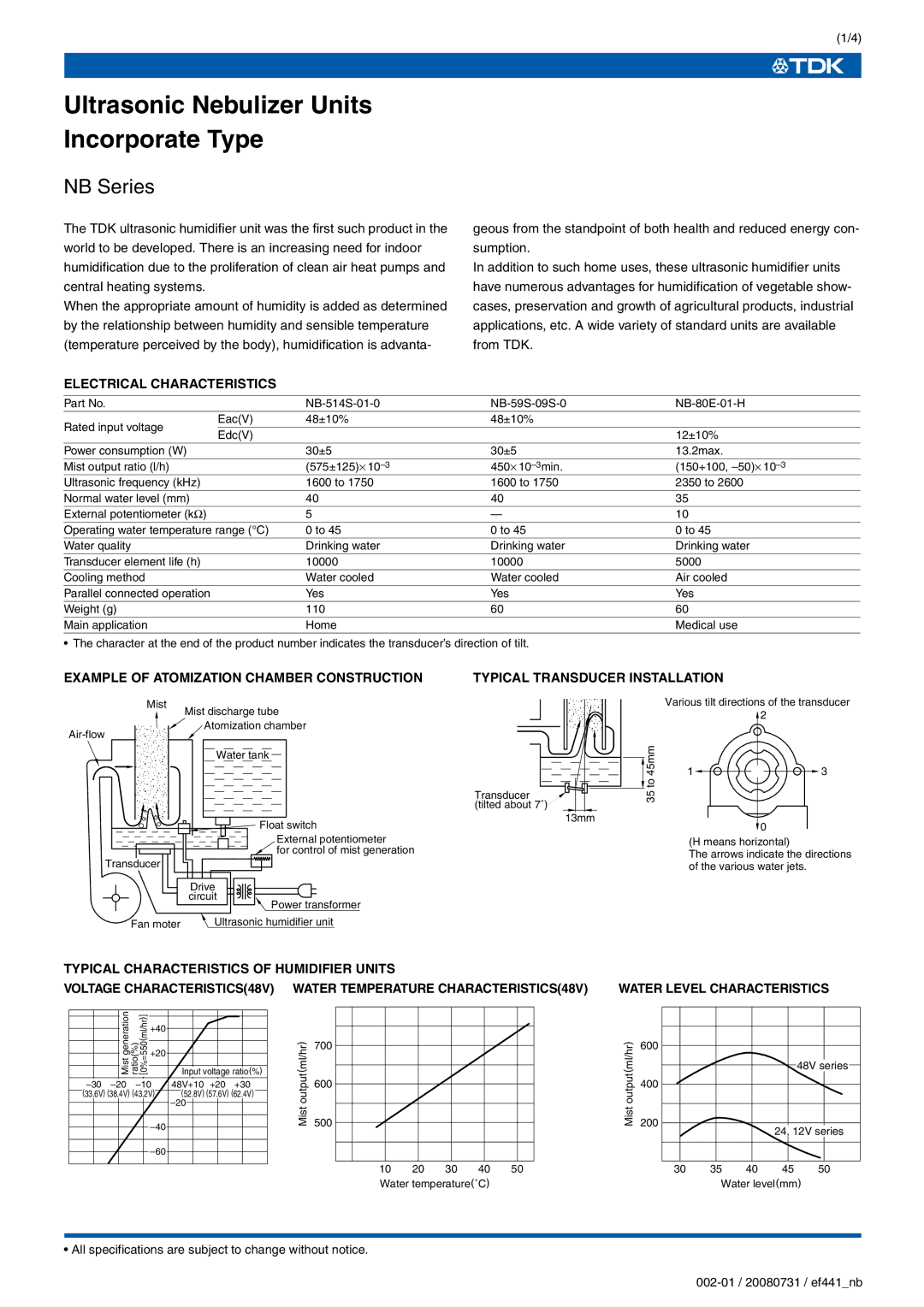
(1/4)
Ultrasonic Nebulizer Units Incorporate Type
NB Series
The TDK ultrasonic humidifier unit was the first such product in the world to be developed. There is an increasing need for indoor humidification due to the proliferation of clean air heat pumps and central heating systems.
When the appropriate amount of humidity is added as determined by the relationship between humidity and sensible temperature (temperature perceived by the body), humidification is advanta-
ELECTRICAL CHARACTERISTICS
geous from the standpoint of both health and reduced energy con- sumption.
In addition to such home uses, these ultrasonic humidifier units have numerous advantages for humidification of vegetable show- cases, preservation and growth of agricultural products, industrial applications, etc. A wide variety of standard units are available from TDK.
Part No. | ||||
Rated input voltage | Eac(V) | 48±10% | 48±10% |
|
Edc(V) |
|
| 12±10% | |
|
|
| ||
Power consumption (W) | 30±5 | 30±5 | 13.2max. | |
Mist output ratio (l/h) | (575±125)⋅ | 450⋅ | (150+100, | |
Ultrasonic frequency (kHz) | 1600 to 1750 | 1600 to 1750 | 2350 to 2600 | |
Normal water level (mm) | 40 | 40 | 35 | |
External potentiometer (kΩ) | 5 | — | 10 | |
Operating water temperature range (°C) | 0 to 45 | 0 to 45 | 0 to 45 | |
Water quality | Drinking water | Drinking water | Drinking water | |
Transducer element life (h) | 10000 | 10000 | 5000 | |
Cooling method | Water cooled | Water cooled | Air cooled | |
Parallel connected operation | Yes | Yes | Yes | |
Weight (g) | 110 | 60 | 60 | |
Main application | Home |
| Medical use | |
• The character at the end of the product number indicates the transducer’s direction of tilt.
EXAMPLE OF ATOMIZATION CHAMBER CONSTRUCTION
TYPICAL TRANSDUCER INSTALLATION
Mist
Transducer
Mist discharge tube
Atomization chamber
Water tank
Float switch
External potentiometer
for control of mist generation
Drive
circuit
Power transformer
Transducer (tilted about 7˚)
35 ![]() 45mmto
45mmto
13mm
Various tilt directions of the transducer ![]() 2
2
1 | 3 |
![]() 0
0
(H means horizontal)
The arrows indicate the directions of the various water jets.
Fan moter | Ultrasonic humidifier unit |
TYPICAL CHARACTERISTICS OF HUMIDIFIER UNITS
VOLTAGE CHARACTERISTICS(48V) WATER TEMPERATURE CHARACTERISTICS(48V)
WATER LEVEL CHARACTERISTICS
|
|
|
| generationMist | ratio(%) [ |
|
|
|
|
| |
|
|
|
|
| )] |
|
|
|
|
| |
|
|
|
|
| ml/hr |
|
|
|
|
| |
|
|
|
|
|
|
| +40 |
| |||
|
|
|
|
| ( |
|
|
| |||
|
|
|
|
|
|
|
|
|
| ||
|
|
|
|
|
|
|
|
|
| ||
|
|
|
|
| 0%=550 |
|
|
|
|
| |
|
|
|
|
|
| +20 |
| ||||
|
|
|
|
|
|
|
|
| |||
|
|
|
|
|
|
|
|
|
|
| |
|
|
|
|
|
|
|
|
|
|
|
|
|
|
|
|
|
|
|
|
|
|
|
|
|
| ||||||||||
| (33.6V) (38.4V) (43.2V) |
| |||||||||
|
|
|
|
|
|
|
|
|
|
|
|
|
|
|
|
|
|
|
|
|
|
| |
|
|
|
|
|
|
|
|
| |||
|
|
|
|
|
|
|
| ||||
|
|
|
|
|
|
|
|
|
|
| |
|
|
|
|
|
|
|
|
|
|
|
|
|
|
|
|
|
|
|
|
| |||
|
|
|
|
|
|
| |||||
|
|
|
|
|
|
|
|
|
|
|
|
|
|
|
|
|
|
|
|
|
|
|
|
Input voltage ratio(%)
48V+10 +20 +30 (52.8V) (57.6V) (62.4V)
) | 700 | |
ml/hr | ||
| ||
( | 500 | |
outputMist | ||
| 600 |
10 20 30 40 50 Water temperature(˚C)
) | 600 |
|
|
|
|
|
|
|
|
|
|
|
|
|
|
|
|
|
|
|
|
|
|
|
|
|
| ||
ml/hr |
|
|
|
|
|
|
|
|
|
|
|
|
| |
|
|
|
|
|
|
|
|
|
|
|
|
|
| |
|
|
|
|
|
|
|
|
| 48V | series |
| |||
|
|
|
|
|
|
|
|
|
| |||||
( |
|
|
|
|
|
|
|
|
|
| ||||
outputMist | 200 |
|
|
|
|
|
|
|
|
|
|
|
|
|
| 400 |
|
|
|
|
|
|
|
|
|
|
|
|
|
|
|
|
|
|
|
|
|
|
|
|
|
| ||
|
|
|
|
|
|
|
| 24, | 12V series |
| ||||
|
|
|
|
|
|
|
|
|
|
|
|
|
|
|
|
|
|
|
|
|
|
|
|
|
|
|
|
|
|
| 30 | 35 | 40 | 45 |
| 50 |
|
| ||||||
|
|
|
|
| Water level(mm) |
|
|
|
| |||||
• All specifications are subject to change without notice.
